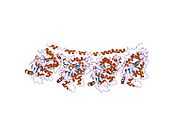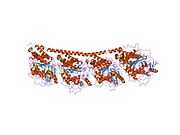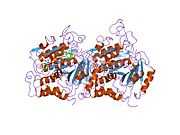TUBB
For persons named Tubb, see Tubb.
Tubulin beta chain is a protein that in humans is encoded by the TUBB gene.[1][2][3]
Interactions
TUBB has been shown to interact with NCOA6[4] and SYT9.[5]
See also
References
- ↑ Crabtree DV, Ojima I, Geng X, Adler AJ (Aug 2001). "Tubulins in the primate retina: evidence that xanthophylls may be endogenous ligands for the paclitaxel-binding site". Bioorg Med Chem 9 (8): 1967–76. doi:10.1016/S0968-0896(01)00103-1. PMID 11504633.
- ↑ Volz A, Weiss E, Trowsdale J, Ziegler A (Feb 1994). "Presence of an expressed beta-tubulin gene (TUBB) in the HLA class I region may provide the genetic basis for HLA-linked microtubule dysfunction". Hum Genet 93 (1): 42–6. doi:10.1007/BF00218911. PMID 8270253.
- ↑ "Entrez Gene: TUBB tubulin, beta".
- ↑ Goo, Young-Hwa; Sohn Young Chang, Kim Dae-Hwan, Kim Seung-Whan, Kang Min-Jung, Jung Dong-Ju, Kwak Eunyee, Barlev Nickolai A, Berger Shelley L, Chow Vincent T, Roeder Robert G, Azorsa David O, Meltzer Paul S, Suh Pan-Gil, Song Eun Joo, Lee Kong-Joo, Lee Young Chul, Lee Jae Woon (Jan 2003). "Activating Signal Cointegrator 2 Belongs to a Novel Steady-State Complex That Contains a Subset of Trithorax Group Proteins". Mol. Cell. Biol. (United States) 23 (1): 140–9. doi:10.1128/MCB.23.1.140-149.2003. ISSN 0270-7306. PMC 140670. PMID 12482968.
- ↑ Haberman, Yael; Grimberg Elena, Fukuda Mitsunori, Sagi-Eisenberg Ronit (Nov 2003). "Synaptotagmin IX, a possible linker between the perinuclear endocytic recycling compartment and the microtubules". J. Cell. Sci. (England) 116 (Pt 21): 4307–18. doi:10.1242/jcs.00719. ISSN 0021-9533. PMID 12966166.
Further reading
- Berrieman HK, Lind MJ, Cawkwell L (2004). "Do beta-tubulin mutations have a role in resistance to chemotherapy?". Lancet Oncol. 5 (3): 158–64. doi:10.1016/S1470-2045(04)01411-1. PMID 15003198.
- Horisberger MA (1992). "Interferon-induced human protein MxA is a GTPase which binds transiently to cellular proteins". J. Virol. 66 (8): 4705–9. PMC 241296. PMID 1629950.
- Wang D, Villasante A, Lewis SA, Cowan NJ (1987). "The mammalian beta-tubulin repertoire: hematopoietic expression of a novel, heterologous beta-tubulin isotype". J. Cell Biol. 103 (5): 1903–10. doi:10.1083/jcb.103.5.1903. PMC 2114403. PMID 3782288.
- Lee MG, Lewis SA, Wilde CD, Cowan NJ (1983). "Evolutionary history of a multigene family: an expressed human beta-tubulin gene and three processed pseudogenes". Cell 33 (2): 477–87. doi:10.1016/0092-8674(83)90429-4. PMID 6688039.
- Hall JL, Dudley L, Dobner PR et al. (1983). "Identification of two human beta-tubulin isotypes". Mol. Cell. Biol. 3 (5): 854–62. PMC 368608. PMID 6865944.
- Andersson B, Wentland MA, Ricafrente JY et al. (1996). "A "double adaptor" method for improved shotgun library construction". Anal. Biochem. 236 (1): 107–13. doi:10.1006/abio.1996.0138. PMID 8619474.
- Yu W, Andersson B, Worley KC et al. (1997). "Large-Scale Concatenation cDNA Sequencing". Genome Res. 7 (4): 353–8. doi:10.1101/gr.7.4.353. PMC 139146. PMID 9110174.
- Kinnunen T, Kaksonen M, Saarinen J et al. (1998). "Cortactin-Src kinase signaling pathway is involved in N-syndecan-dependent neurite outgrowth". J. Biol. Chem. 273 (17): 10702–8. doi:10.1074/jbc.273.17.10702. PMID 9553134.
- Niethammer M, Valtschanoff JG, Kapoor TM et al. (1998). "CRIPT, a novel postsynaptic protein that binds to the third PDZ domain of PSD-95/SAP90". Neuron 20 (4): 693–707. doi:10.1016/S0896-6273(00)81009-0. PMID 9581762.
- Rasmussen RK, Ji H, Eddes JS et al. (1998). "Two-dimensional electrophoretic analysis of mixed lineage kinase 2 N-terminal domain binding proteins". Electrophoresis 19 (5): 809–17. doi:10.1002/elps.1150190535. PMID 9629920.
- Ciruela F, Robbins MJ, Willis AC, McIlhinney RA (1999). "Interactions of the C terminus of metabotropic glutamate receptor type 1alpha with rat brain proteins: evidence for a direct interaction with tubulin". J. Neurochem. 72 (1): 346–54. doi:10.1046/j.1471-4159.1999.0720346.x. PMID 9886087.
- Chau MF, Radeke MJ, de Inés C et al. (1999). "The microtubule-associated protein tau cross-links to two distinct sites on each alpha and beta tubulin monomer via separate domains". Biochemistry 37 (51): 17692–703. doi:10.1021/bi9812118. PMID 9922135.
- Piredda L, Farrace MG, Lo Bello M et al. (1999). "Identification of 'tissue' transglutaminase binding proteins in neural cells committed to apoptosis". FASEB J. 13 (2): 355–64. PMID 9973324.
- Feng Y, Hodge DR, Palmieri G et al. (1999). "Association of polo-like kinase with alpha-, beta- and gamma-tubulins in a stable complex". Biochem. J. 339 (2): 435–42. doi:10.1042/0264-6021:3390435. PMC 1220175. PMID 10191277.
- Martín L, Fanarraga ML, Aloria K, Zabala JC (2000). "Tubulin folding cofactor D is a microtubule destabilizing protein". FEBS Lett. 470 (1): 93–5. doi:10.1016/S0014-5793(00)01293-X. PMID 10722852.
- Tarazona R, López-Lluch G, Galiani MD et al. (2001). "HLA-B2702 (77-83/83-77) peptide binds to beta-tubulin on human NK cells and blocks their cytotoxic capacity". J. Immunol. 165 (12): 6776–82. doi:10.4049/jimmunol.165.12.6776. PMID 11120798.
- Bonnet C, Boucher D, Lazereg S et al. (2001). "Differential binding regulation of microtubule-associated proteins MAP1A, MAP1B, and MAP2 by tubulin polyglutamylation". J. Biol. Chem. 276 (16): 12839–48. doi:10.1074/jbc.M011380200. PMID 11278895.
- Ivings L, Pennington SR, Jenkins R et al. (2002). "Identification of Ca2+-dependent binding partners for the neuronal calcium sensor protein neurocalcin delta: interaction with actin, clathrin and tubulin". Biochem. J. 363 (Pt 3): 599–608. doi:10.1042/0264-6021:3630599. PMC 1222513. PMID 11964161.
| |||||||||||||||||||||||||||










